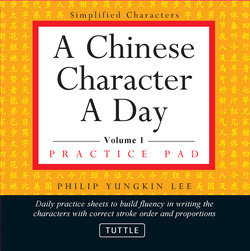Читать книгу Chinese Character a Day Practice Pad Volume 1 - Philip Yungkin Lee - Страница 4
На сайте Литреса книга снята с продажи.
ОглавлениеPRONUNCIATION TIPS
All words in Chinese have a tone, and an incorrect tonal pronunciation can greatly change a word’s meaning. For example:
First tone (): The word mā spoken with the first tone means “mother". The first tone is an even pitched sound, almost like singing.
Second tone (): The word má with the second tone means “hemp". The second tone rises, like one would say the word “right?”
Third tone (): The word mǎ spoken with the third tone means “horse". It is pronounced with a lowering of the voice.
Fourth tone (): The word mà with the fourth tone means “to scold" (for instance, if one were to reprimand someone, one would mà the said individual). The fourth tone is spoken sharply, like the word “Damn!"
There is one more tone, ma (without a tone marking), referred to as the neutral tone, which depends on the tone that precedes it.
Change of tone:
When 2 third tones come in succession. a change of tone occurs and the first third tone is to be pronounced in the second tone.
Just as English is spoken with different accents, so is Chinese; learners of Chinese must therefore develop an ear for the language.
CONSONANTS
The following offers a guide to the pronunciation of the standard Hanyu Pinyin system of romanization, which is used almost all over the world.
Most consonants are pronounced as in English.
| Chinese | English |
| c | its |
| ci | its (silent ‘‘i”) |
| q | cheat (said with a puff of air) |
| qi | chip (silent “i") |
| r | urn |
| si | swing |
| x | sea |
| z | bits |
| zi | bits (silent “i") |
| ch | church (said with one’s tongue rolled back and with a puff of air) |
| sh | she (said with one’s tongue rolled back) |
| zh | jerk (said with one’s tongue rolled back) |
VOWELS
| Pinyin | English |
| a | father |
| e | hen |
| i | pin (single “i" is pronounced “e" as in he). |
| o | go |
| u | July |
| ü | feud (said with rounded lips) |
| ao | how |
| ei | hay |
| ou | no (said with a slight pull) |
| ui | wait |
